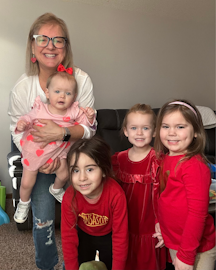Soon after Miriam Bravo began watching her 2-year-old grandson full-time, she realized that many years had passed since she was last responsible for a young child. Feeling a bit rusty, she turned to the internet to seek out activities suitable for little Tadeo and advice for how best to support him.
She found some resources online, such as songs to sing with him, but Bravo wanted more.
Bravo is part of a group of caregivers often referred to as family, friend and neighbor (FFN) providers. Although this is the most common non-parental child care arrangement in the United States, used by millions of families, few options for training and education are available to FFN providers. Most early care and education supports are reserved for licensed child care providers or parents. And the limited professional development opportunities available to FFNs are often inaccessible, due to factors such as costs, scheduling and language barriers.
So it was lucky that when Bravo knocked on the door of a community center near her home in San Jose, California, wondering whether they had any programs to help her improve as a caregiver, she found exactly what she was looking for.
In Bravo’s northern California community, a home visiting service called ParentChild+ has adapted its well-established model for parents to fit the needs and priorities of home-based child care providers, including FFNs.
For decades, evidence-based home visits from trained professionals have supported families across the U.S. These programs empower parents to engage their children with high-quality, developmentally appropriate activities; promote social-emotional skills and school readiness among kids; and foster a safe, healthy, nurturing home environment. More recently, a number of national home visiting programs have recognized an opportunity to reach more children by serving home-based child care providers, too, and there’s evidence to show it’s making a difference.
“This is promising,” says Natalie Renew, executive director of Home Grown, a national initiative to increase access to and quality of home-based child care, “especially in a landscape where there are so few other interventions.”
In the last few years, Home Grown has provided grants to three home visiting programs that serve home-based providers — ParentChild+, Parents as Teachers and Home Instruction for Parents of Preschool Youngsters — to help them better understand the needs of the caregivers they’re engaging, learn what factors contribute to the success of the programs and, ultimately, expand their footprint.
It’s an investment in an often-overlooked but invaluable caregiver population that, in most cases, was already looking for ways to provide higher quality care and education to children, explains Kerry Caverly, chief program office at Parents as Teachers.
“People want to do right by kids and many times don’t have the tools or knowledge of what the right thing is,” Caverly says. “Sometimes it’s just bringing in new opportunities.”
An Organic Expansion
Bravo signed on to the free, voluntary, home-based child care model with ParentChild+ right away. Since February, Stephanie, the home visitor assigned to Bravo, has been visiting her and Tadeo twice a week.
Stephanie brings books, toys and materials that Bravo keeps and can use during future learning activities with Tadeo. But her home visitor’s biggest contributions, Bravo shares in Spanish through an interpreter, are less tangible.
Tadeo lights up when Stephanie arrives, Bravo says. He’s eager to find out which activity she planned for him that day. His motor skills have improved, and now, at 2-and-a-half years old, he’s cutting with scissors — a task that many children have not yet mastered by kindergarten. He is able to focus and complete activities that his attention span did not allow even a few months ago.
Bravo, for her part, has gained confidence. She has become a more patient, loving caregiver, she says. “It’s brought us closer.” She sees herself now as more than Tadeo’s grandmother; she is his teacher as well.

The ParentChild+ home-based child care model emerged organically, says Sarah Walzer, CEO of the organization, which started in 1965 as a home visiting program for parents and today serves a majority immigrant population that speaks over 40 languages.
A little over a decade ago, home visitors reported that a number of parents in their caseload were caring for other children in the community. Over the next few years, in response to that need, ParentChild+ built out a parallel model tailored to home-based child care providers, including FFNs. Today, the program has a presence in 10 states.
The program for home-based providers runs for 24 weeks, compared to 46 weeks for families. The visits are designed around hands-on learning activities and play, Walzer says, adding that the goal is to improve the quality of the child care and to build school readiness for children, with attention to the learning environment and adult-child interactions.
Their work is strengths-based, Walzer explains. Home visitors seek to identify what’s already working and build on it — that’s true of other home visiting models and of home visits targeted to parents.
“We don’t go in there to find what is missing, lacking or illegal,” Walzer says. “We go in to look at what is going really well and strengthen areas of child care” based on evidence-based practices.
Parents as Teachers has a similar origin story for its home-based child care model, which they call “Supporting Care Providers Through Person Visits” (SCPV).
It was the late 1990s, and more women were entering the workforce, recalls Caverly, the chief program officer. More families, as a result, were seeking out child care arrangements. Home visitors serving families across the country were sharing that they’d show up for home visits and find a relative or neighbor with the child instead of the parent.
“It really got us thinking,” Caverly remembers.
Parents as Teachers adapted its curricula and built out the SCPV program, which is currently being used in 12 states. (With funding from Home Grown, they are updating their curricula for home-based providers and will spend much of 2025 using those new resources to expand their reach.)
Both Parents as Teachers and ParentChild+ serve a mix of licensed home-based child care providers and unlicensed FFNs through their home visiting programs, but “at the heart of it is FFNs,” says Caverly, adding that their work with FFNs does look, in a lot of ways, like their work with families.
One of the key distinctions between their work with providers and families, she says, is that providers learn how to do screenings and evaluations of the children in their care.
That element was especially valuable for Gretchen Dunn, a licensed provider in Olathe, Kansas.
Dunn has owned her home-based child care program for 25 years, she says, but when she heard Parents as Teachers was offering home visits for providers, she called up her local site and asked to participate.
She’s a seasoned provider who attends annual training, she acknowledges, but she liked the idea of getting a “refresher” and the chance to observe another early childhood professional interact with the kids in her care.

Over the course of two years, Dunn received monthly home visits, during which her home visitor would usually lead an activity with the kids and leave Dunn with a handout so she could repeat it in the future. The home visitor also brought books. And she helped Dunn screen children for possible developmental delays using the Ages and Stages Questionnaire, something Dunn hadn’t used before in her program. Those evaluations can tell a provider if a child may need to see a specialist — a speech therapist, for example — but they can also help inform providers about appropriate activities and interactions to use with each child.
The entire experience was validating for Dunn, she says. As the sole employee of her program, she has minimal adult interaction during the day. Plus, there is rarely anyone to observe her work or note if she is doing a good job.
“To have someone who actually knows my field and training come in and give me new ideas and support and back me up — all those things, that’s what I enjoyed” the most, she says.
‘Money Well Spent’
Perhaps the biggest hangup of this model is money, according to Renew of Home Grown.
The sites that already exist to provide home visiting services — to both families and providers — say that with more funding, they could reach many more caregivers.
“We know we have a lot of children who will fall through the cracks,” says Maria Rios, a home visitor for Parents as Teachers in Kansas City, Kansas, who has a caseload of 30 home-based child care providers. “I wish there was more funding.”
Rios, a former preschool teacher and school vice principal, is less concerned about children’s academic skills. “They’ll learn their ABCs in school,” she says. It’s the social-emotional skills — how to interact with other children, how to share — that she feels many children need to pick up sooner.
Home visiting programs are expensive to implement, as most high intensity, high integrity services tend to be, says Renew. It’s a big shift, she adds, for states and localities to go from spending zero dollars on FFN providers to investing thousands of dollars in each person. But she thinks it’s feasible, especially given the number of children who stand to benefit.
A few different funding models are in play already. The state of Colorado has used its Preschool Development Grant Birth to Five dollars on home visiting. And ParentChild+ is getting public funding, including dollars from the federal pandemic-era American Rescue Plan Act, to support its home-based child care programming at several sites, including New York state and counties in North Carolina.
“From our perspective,” says Renew, “it’s money well spent.”
It certainly has been for Bravo, the FFN provider in California. Both the mentorship from her home visitor and the new community she has found among other FFNs in her area have made for a “beautiful experience.”
“It’s not just a program,” Bravo adds, “it’s a family.”
Equipped with new caregiving expertise, she’s thought about taking in more children. She is open to the idea, she says. At a minimum, she’ll get to use her knowledge with future grandchildren.
- SEO Powered Content & PR Distribution. Get Amplified Today.
- PlatoData.Network Vertical Generative Ai. Empower Yourself. Access Here.
- PlatoAiStream. Web3 Intelligence. Knowledge Amplified. Access Here.
- PlatoESG. Carbon, CleanTech, Energy, Environment, Solar, Waste Management. Access Here.
- PlatoHealth. Biotech and Clinical Trials Intelligence. Access Here.
- Source: https://www.edsurge.com/news/2024-06-11-home-visiting-programs-aren-t-just-for-families-they-can-support-child-care-providers-too



